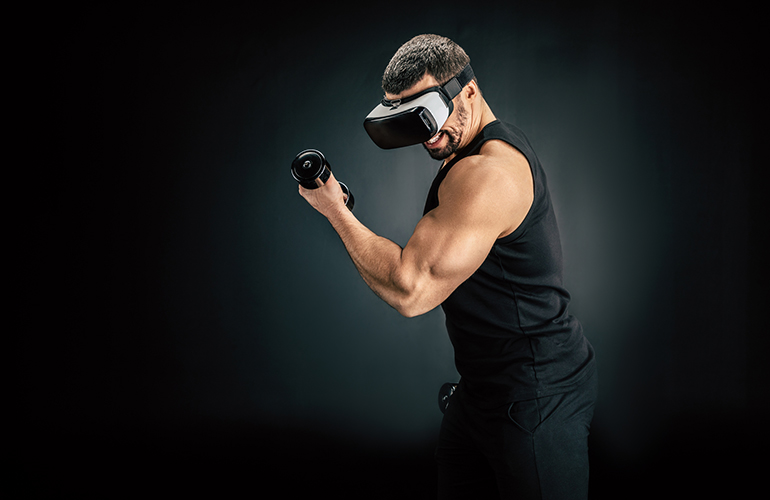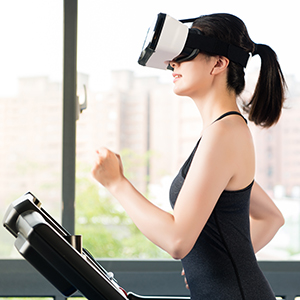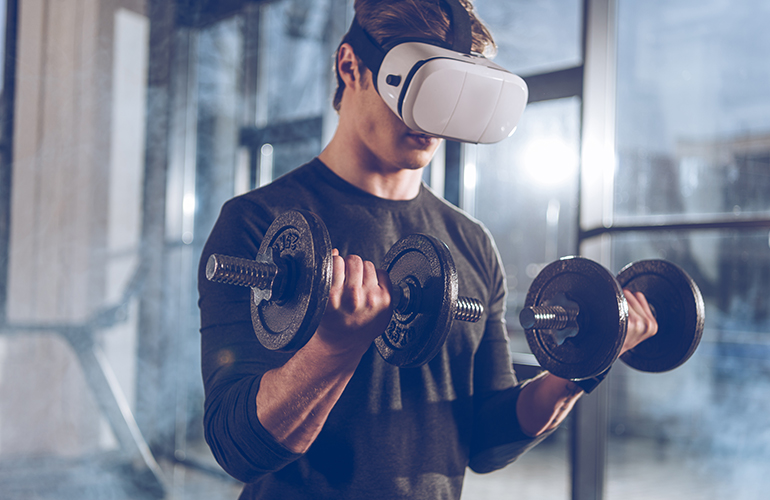Yes, we all know about wearables. Seeing as every second person seems to be wearing either a Fitbit or Jawbone device and counting their daily steps.
And, of course, the Nintendo Wii has been around for a while, getting people to golf, bowl and dance in the comfort of their own living rooms. Then, there’s the rise in personal training online or even taking part in classes that are streamed.
There are definite bonuses to VR – virtual reality. You can do in your own home, and that’s a big plus. For a start, you could exercise in your pajamas if you wanted. And when exercise opportunities are presented to you without you having to go anywhere, double bonus.
VR For Bodybuilding And Fitness
What about virtual reality’s applications to bodybuilding?
Not as simple, right?
While tech solutions such as a streamed class or online workout programs with videos can give you the ‘at-home’ and ‘do it anywhere’ versatility aspect, neither is truly immersive.
There is also the monotony element to consider. Go to the gym, pick up weight, lift heavy, repeat. It’s a formula that has not changed much in the last fifty or so years. Neither have gyms. Go into one twenty years ago, and it will not look that different from the one you walk into today.

Virtual Reality PT – Personal Trainer
One of the biggest ways VR could influence the bodybuilding and fitness game is through personal trainers.
Instead of having to go to the gym to get a personal trainer, or hire one to workout with you, you could simply slide on some glasses and the PT would be standing in front of you.
Customized Workouts And Exercises Plan
They could then direct you with what you have to do, show you the correct form, and guide you through your workout. In the long run, this could prove to be much cheaper and cost-effective. Not to mention the fact that you wouldn’t have to rely on anyone else’s schedule.
As well as this, the virtual trainer will have access to an extensive library of knowledge, not just of health and fitness, but of your personal history. This will mean they can create programs specifically for your needs and interestingly, possibly a more personal experience.
Workout Analysis And Feedback
The VR equipment would automatically log and analyze all of your workouts. Whilst a normal personal trainer is subjected to human error such as looking away or forgetting things. A computer doesn’t have this.
The computer could perfectly analyze your movement, let you know where you’re going wrong and what you need to do next time, then show you real-time footage of how to proceed from there. You could pull up data on your progression over time with graphs and tables alongside your goals and where you want to end up.
On top of this, you could combine apps to give you a complete, all-around fitness experience. Once you’ve left the gym that’s usually where your time with your personal trainer ends.
Yet, VR could link up with your phone to give you recipes and meals based on your workout. If you’re going for a more endurance-based approach, you might be recommended a higher-carbohydrate meal. If you’re looking for strength, it could suggest you some high-protein options.
The VR could also directly send to your phone how many calories you’ve burned or conversely, the app could tell your VR what you’ve eaten recently and the VR could base your workouts off of that – whether you need to work a little harder or hold back a little.
VR Workout Anywhere Experience
 Another experience would be being able to pick where you’re running. Instead of just pounding the rotating rubber of the treadmill, you could run through California, Spain or Iceland.
Another experience would be being able to pick where you’re running. Instead of just pounding the rotating rubber of the treadmill, you could run through California, Spain or Iceland.
Add in a dynamic treadmill that reacts to the terrain before you by adjusting the incline and the experience would be completely immersive.
What if you could also be involved in a different storyline every time you worked out too?
Instead of just running along the pavement you’re chasing an evil villain or directly in your favorite movie scene. Your workouts could have you solve a different mystery every time you exercised.
Imagine if your workout regime revolved around an entire storyline, similar to that of a game. Each time you put on your VR goggles you progressed a little bit further, did an extra mission or earned a new prize.
Game Or Movie Based Workouts
If you’ve ever played an MMORPG (Mass-Multiplayer Online Role Playing Game) such as World of Warcraft, then you could even pick the class of your character. Imagine that each time you leveled up in your online world you were also progressing in real life, getting leaner, stronger, faster, more powerful, and all-around fitter.
You could drop weight as you solved quests, found treasure, and made online friends. You’d be learning functional skills that would translate into the real world.
If you could link the VR to other devices, then it could suggest workouts based on your favorite movies and TV shows. For instance, if you’ve just watched the latest Transformers movie and gave it a good rating, then the VR equipment might suggest to you a workout based around one of the plot lines – dodging rockets and giant mechanical feet as you try to find Optimus Prime.
Not to mention that the world of celebrity endorsements could be incredible. Chris Hemsworth’s workout routine for Thor is no longer just a set gym plan. It places you as Thor himself battling baddies and saving civilians. You could create your own character and become one of the Avengers.
What virtual reality offers is to take the addictive quality of video games and convert them into health and fitness benefits. Your body is the controller. The better you are at the game, the more your strength, flexibility and fitness gets because how you perform in the game depends entirely on your movements.
The fitness bit becomes secondary to the game. You’re so busy trying to better yourself and beat your virtual competitors (or whatever), that you forget you’re engaged in the process of building strength and fitness.
What Can Virtual Reality Offer Bodybuilders?
- It “gamifies” movement, using features from popular games, making exercise fun and addictive
- By focusing on the game, the user concentrates less on the exhaustive or difficult part of getting fit, so pain perception decreases
- They can take you into a ‘flow’ state, making time pass in a truly enjoyable way – unlike a gym where you might spend your time watching that second hand like a hawk
- Your movements will be tracked, so like those athletes and team members, you will get lots of feedback on what you did and tips for what you need to work on and improve.

Black Box VR Project
And like all brand-new shiny things, virtual reality has its champions. Take Ryan DeLuca. He wants to change the way people experience fitness, taking tech to a new level with his latest invention.
Who is Ryan DeLuca, you ask?
Someone with a LOT of experience in the bodybuilding world, seeing as he’s the guy who founded the mighty Bodybuilding.com, the world’s largest source of articles, videos, exercises, workouts, supplements and community, and a site that benefits from more than a million visitors every day.
As you might imagine, someone so immersed in the fitness world always wants to stay ahead of the game. DeLuca stepped down from his position as CEO of Bodybuilding.com two years ago. But he’s not someone to rest on his laurels, and since then he’s been looking at the concept of gyms and wondering how he can improve them. He and his business partner came up with Black Box VR.
Black Box VR offers a complete resistance and cardio training workout, designed by fitness experts and athletes. Three 45-minute workouts a week, the company claims, are enough to ‘skyrocket’ your fitness, while making it fun and enjoyable at the same time.
“You aren’t working out. You are saving the city. Or solving a mystery. Or finding the treasure,” the promotional literature claims. “You are inside your own movie, and as you reach out to pull that rope or lift the handles on the block, you’ll really feel them there. Functional fitness in a fictional world.”
The workouts, they say, will automatically move people towards their goals by refining the resistance, intensity, and speed based on an individual’s goals and their current progress. And they don’t allow plateaus.
The company has plans to set up flagship gyms in key areas – Manhattan and Beverley Hills. And their business model seems to be going down the licensing route, where gyms pay subscriptions to add Black Box VR workouts to their existing programmes. There are also franchise opportunities for those who want to open their own Black Box VR gym.
VR For Training
Athletes and sports teams already use virtual reality options for training. Someone can become fully immersed in the experience, and their movements tracked. The feedback will be detailed, allowing the person to learn and adapt their position and actions, improving how they perform.
The company, STRIVR, for example, claims to change the way athletes prepare for competition. Its immersive technology allows players to practice just as if they were out on the field, court or ice rink.
One of their success stories is Clemson’s star quarterback, Deshaun Watson [American football, university league]. He used VR to supplement his training with off-field reps throughout the 2016 season.
He watched and studied hundreds of situations, paying particular attention towards blitz pick-ups. The training paid off when Clemson played the University of Alabama, and Deshaun went 6-7 with 2TDs, and the team claimed its first national title since 1981.
STRIVR
What the STRIVR model teaches is that repetition is the key to learning. Their data suggests that users can increase reactions times by 20 percent, crucial in situations where every second count.
For athletes and sports stars, this means that everyone has access to the world’s best coach, the tracking helps improve performance, and the athlete receives an enormous amount of detailed feedback.
Training can be practiced in a small area, such as a garage and team players can work by themselves, instead of needing their teammates. There’s no doubt this is the future.
Increasingly, coaching bodies and sports teams will be making the most of this innovative technology in years to come. The only barrier will be how much money they can invest in such solutions. But it is likely virtual reality options will work out cheaper overall.
The Pros
Addictive Qualities Used To Advantage
No doubt, this kind of technology will spread. Black Box VR will find itself in competition with others soon enough. It promises much for the bodybuilder.
The overwhelming bonus seems to be the take on what is often regarded as the unhealthy aspect of video games – their addictive quality. We all know people who spend hours playing them, hunched over a console and hidden away in darkness, their eyes fixed on a screen.
If so many people can play games for hours, why not give them that game in a different form where they need to work for it?
Imagine looking forward to your workout! I can’t wait to lift weights, said not many people ever. I can’t wait to get back to that game and trounce the bad guy/win the war, etc.
Much more appealing, huh?
Challenges
However, there are issues that present themselves.
Availability And Price
The first and most obvious is that the technology is simply not up to scratch at the minute to provide a fully immerse experience of this quality. As well as this, any VR that could match these specifications is far out of reach for most people’s budget.
That’s okay. Money-making potential will always dilute the price of something to make it affordable for the many. Expect to see some kind of virtual reality offering in a gym near you soon.
Social Impact
There’s also the social impact. Many people prefer the personal touch of one-to-one training with a real-life human being.
Though you would possibly be able to meet up in the online world with your friends. Many of us go to the gym with a partner or in a group. If we’ve spent a whole day staring at a screen for work, would we really then want to meet our friends through another screen?
Even if the VR equipment simply projects additional aspects onto our real-world vision, such as by showing you your normal gym. But having a VR trainer beamed in front of you, there’s still a degree of separation created by the goggles.
Conclusion
We like virtual reality, but we don’t see it as THE solution for fit and healthy society. VR can’t replicate all the benefits of good, old-fashioned workout, but it can complement it.
It will be exciting to see how it develops once the trickle-down effect happens.
What is your opinion?
Let us know in the comments.
Resources:
- Matthew Schnipper. “Seeing is Believing: The State of Virtual Reality”. The Verge. Retrieved 7 March 2017
- Holly Brockwell (3 April 2016). “Forgotten genius: the man who made a working VR machine in 1957”. Tech Radar. Retrieved 7 March 2017.
- “VR and vice: Are we heading for mass addiction to virtual reality fantasies”. Wareable. Retrieved 2016-06-19
- Virtual reality Wikipedia https://en.wikipedia.org/wiki/Virtual_reality
- Virtual Training for Football is Becoming a Reality https://onlinemasters.ohio.edu/virtual-training-for-football-is-becoming-a-reality/
- Black Box VR Project https://www.blackbox-vr.com/about-us/
- STRIVR Project https://strivr.com/sports/
One Response
Yup, VR and gamification is the future of well..everything. From fitness, to health, and life coaching. As soon as the technology catches up…which will take a few years, but its coming.